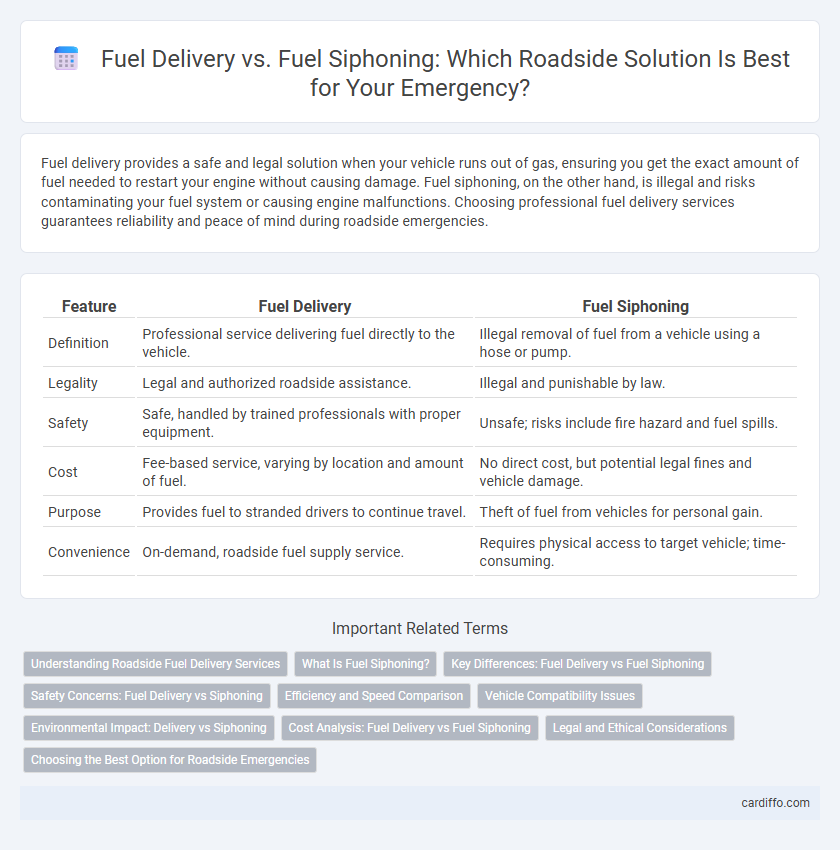Fuel delivery provides a safe and legal solution when your vehicle runs out of gas, ensuring you get the exact amount of fuel needed to restart your engine without causing damage. Fuel siphoning, on the other hand, is illegal and risks contaminating your fuel system or causing engine malfunctions. Choosing professional fuel delivery services guarantees reliability and peace of mind during roadside emergencies.
Table of Comparison
| Feature | Fuel Delivery | Fuel Siphoning |
|---|---|---|
| Definition | Professional service delivering fuel directly to the vehicle. | Illegal removal of fuel from a vehicle using a hose or pump. |
| Legality | Legal and authorized roadside assistance. | Illegal and punishable by law. |
| Safety | Safe, handled by trained professionals with proper equipment. | Unsafe; risks include fire hazard and fuel spills. |
| Cost | Fee-based service, varying by location and amount of fuel. | No direct cost, but potential legal fines and vehicle damage. |
| Purpose | Provides fuel to stranded drivers to continue travel. | Theft of fuel from vehicles for personal gain. |
| Convenience | On-demand, roadside fuel supply service. | Requires physical access to target vehicle; time-consuming. |
Understanding Roadside Fuel Delivery Services
Roadside fuel delivery services provide safe and efficient refueling solutions for stranded motorists, ensuring vehicles receive certified fuel directly at the location without the risk of contamination. Unlike fuel siphoning, which is illegal and damages the vehicle's fuel system, professional fuel delivery maintains fuel quality and protects vehicle warranties. Utilizing certified operators with proper equipment, these services prioritize convenience, safety, and compliance with environmental regulations.
What Is Fuel Siphoning?
Fuel siphoning is the unauthorized extraction of fuel from a vehicle's tank using a hose or tube, often resulting in significant fuel loss and potential damage to the vehicle. This illegal practice compromises vehicle security and can lead to costly repairs or even immobilization. Understanding fuel siphoning is crucial for drivers to implement preventive measures, such as installing anti-siphon devices or parking in well-lit, secure areas.
Key Differences: Fuel Delivery vs Fuel Siphoning
Fuel delivery involves the professional transport and transfer of fuel to vehicles stranded on the roadside, ensuring convenience and safety through authorized services. Fuel siphoning is an illicit act where fuel is stolen by extracting it from a vehicle's tank, often causing damage and loss to the owner. Key differences include legality, purpose, and method: fuel delivery is a legal roadside assistance service aimed at refueling, while fuel siphoning is an unauthorized theft that compromises vehicle security.
Safety Concerns: Fuel Delivery vs Siphoning
Fuel delivery services prioritize safety by using professional-grade equipment and trained technicians to prevent spills, fire hazards, and inhalation risks. In contrast, fuel siphoning poses significant dangers including exposure to toxic fumes, potential ignition sources, and environmental contamination from improper handling. Reliable fuel delivery minimizes these risks through strict safety protocols and proper transfer techniques, ensuring both customer and environmental protection.
Efficiency and Speed Comparison
Fuel delivery services provide fast, efficient refueling directly at the roadside, eliminating delays caused by locating a gas station, which enhances convenience for drivers stranded with empty tanks. In contrast, fuel siphoning is time-consuming, risky, and inefficient, involving manual removal of fuel from another vehicle, often leading to contamination and fuel loss. The efficiency and speed of professional fuel delivery far surpass siphoning, ensuring quick resumption of travel and minimizing downtime.
Vehicle Compatibility Issues
Fuel delivery services are specifically designed to provide compatible fuel types tailored to various vehicle engines, ensuring proper engine performance and avoiding potential damage. In contrast, fuel siphoning risks introducing contaminated or incorrect fuel into a vehicle's system, causing malfunctions and compromising engine reliability. Compatibility issues arise because modern vehicles often require precise fuel formulations that fuel delivery professionals adhere to, unlike the indiscriminate nature of siphoning.
Environmental Impact: Delivery vs Siphoning
Fuel delivery services minimize environmental impact by preventing fuel spills and reducing emissions associated with improperly stored gasoline. Fuel siphoning often leads to hazardous leaks and contamination of soil and water sources, causing long-term ecological damage. Efficient fuel delivery systems incorporate safety measures that protect ecosystems and reduce carbon footprints compared to careless siphoning practices.
Cost Analysis: Fuel Delivery vs Fuel Siphoning
Fuel delivery services typically cost between $50 and $150 per service, providing a reliable and legal solution to avoid vehicle immobilization due to an empty tank. Fuel siphoning, while seemingly cost-free, risks significant financial losses through theft, damage to the fuel system, and potential legal consequences, potentially costing hundreds to thousands of dollars in repairs and fines. Comparing both, fuel delivery offers a transparent and cost-effective approach, minimizing risks and unexpected expenses compared to the high liabilities associated with fuel siphoning.
Legal and Ethical Considerations
Fuel delivery services provide legal and ethical assistance by supplying fuel to stranded motorists, ensuring compliance with transportation laws and safety regulations. In contrast, fuel siphoning is illegal and constitutes theft, posing ethical violations and potential criminal charges. Understanding the distinction between authorized fuel delivery and unlawful siphoning is critical for motorists and service providers to avoid legal repercussions and uphold ethical standards on the roadside.
Choosing the Best Option for Roadside Emergencies
Fuel delivery provides a reliable and safe solution during roadside emergencies by ensuring the vehicle receives the correct type and quality of fuel without risk of contamination. Fuel siphoning poses significant safety hazards, including potential damage to the fuel system and legal consequences, making it a less advisable choice. Opting for professional fuel delivery services maximizes convenience, reduces downtime, and minimizes risks associated with roadside fuel shortages.
Fuel Delivery vs Fuel Siphoning Infographic

 cardiffo.com
cardiffo.com